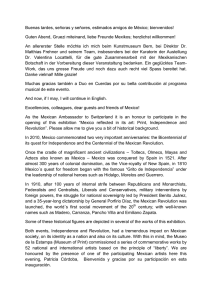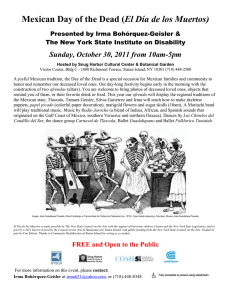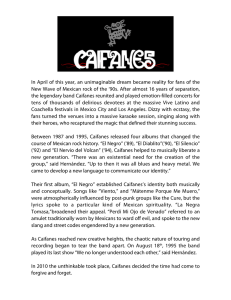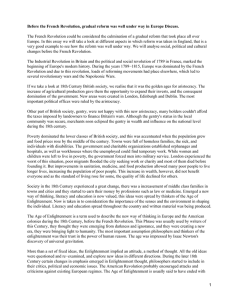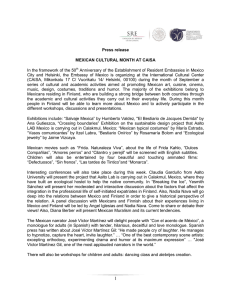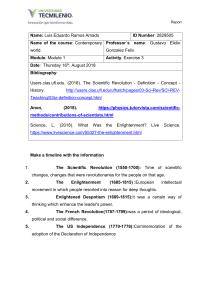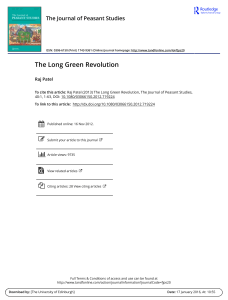The Rise and Fall of the Mexican Revolution Myth in Three Iconic
Anuncio
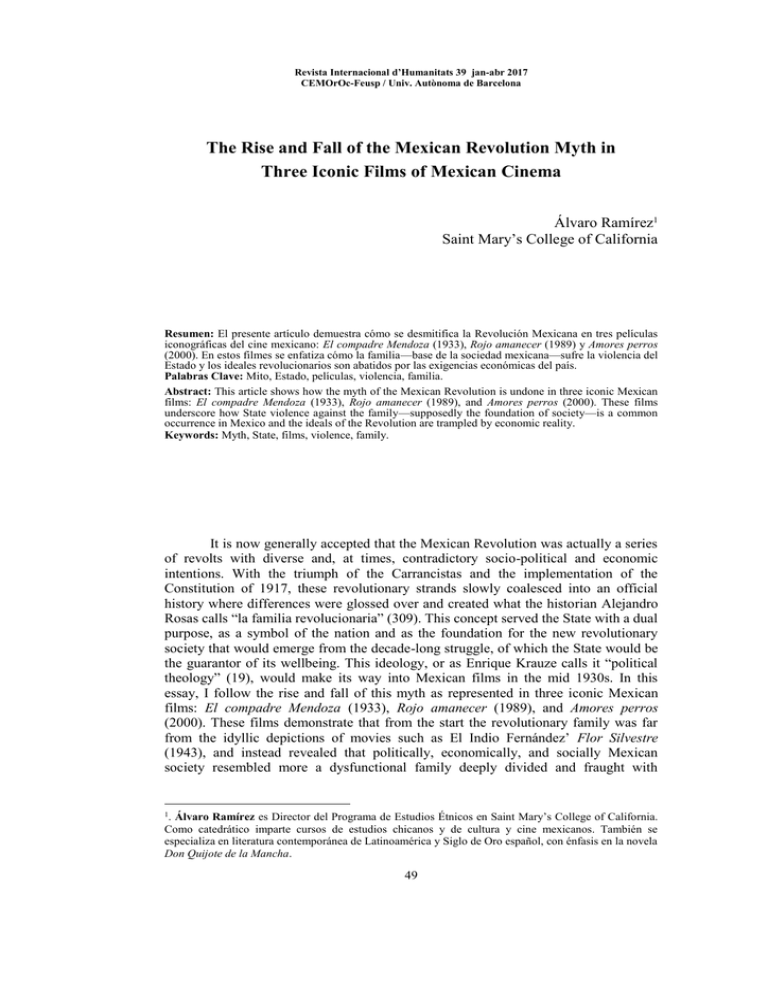
Revista Internacional d’Humanitats 39 jan-abr 2017 CEMOrOc-Feusp / Univ. Autònoma de Barcelona The Rise and Fall of the Mexican Revolution Myth in Three Iconic Films of Mexican Cinema Álvaro Ramírez1 Saint Mary’s College of California Resumen: El presente artículo demuestra cómo se desmitifica la Revolución Mexicana en tres películas iconográficas del cine mexicano: El compadre Mendoza (1933), Rojo amanecer (1989) y Amores perros (2000). En estos filmes se enfatiza cómo la familia—base de la sociedad mexicana—sufre la violencia del Estado y los ideales revolucionarios son abatidos por las exigencias económicas del país. Palabras Clave: Mito, Estado, películas, violencia, familia. Abstract: This article shows how the myth of the Mexican Revolution is undone in three iconic Mexican films: El compadre Mendoza (1933), Rojo amanecer (1989), and Amores perros (2000). These films underscore how State violence against the family—supposedly the foundation of society—is a common occurrence in Mexico and the ideals of the Revolution are trampled by economic reality. Keywords: Myth, State, films, violence, family. It is now generally accepted that the Mexican Revolution was actually a series of revolts with diverse and, at times, contradictory socio-political and economic intentions. With the triumph of the Carrancistas and the implementation of the Constitution of 1917, these revolutionary strands slowly coalesced into an official history where differences were glossed over and created what the historian Alejandro Rosas calls “la familia revolucionaria” (309). This concept served the State with a dual purpose, as a symbol of the nation and as the foundation for the new revolutionary society that would emerge from the decade-long struggle, of which the State would be the guarantor of its wellbeing. This ideology, or as Enrique Krauze calls it “political theology” (19), would make its way into Mexican films in the mid 1930s. In this essay, I follow the rise and fall of this myth as represented in three iconic Mexican films: El compadre Mendoza (1933), Rojo amanecer (1989), and Amores perros (2000). These films demonstrate that from the start the revolutionary family was far from the idyllic depictions of movies such as El Indio Fernández’ Flor Silvestre (1943), and instead revealed that politically, economically, and socially Mexican society resembled more a dysfunctional family deeply divided and fraught with Álvaro Ramírez es Director del Programa de Estudios Étnicos en Saint Mary’s College of California. Como catedrático imparte cursos de estudios chicanos y de cultura y cine mexicanos. También se especializa en literatura contemporánea de Latinoamérica y Siglo de Oro español, con énfasis en la novela Don Quijote de la Mancha. 1. 49 fratricidal violence, which eventually led to the fragmentation of the nation in the closing years of the twentieth century when the long reign of the PRI came to an end. Fernando de Fuentes’ trilogy: Vámonos con Pancho Villa, El prisionero trece, and El compadre Mendoza, is the first to bring the Revolution to the screen at the moment it is reaching its highest pinnacle, but instead of offering celebratory accounts, de Fuentes’ films are extremely critical of the emergent revolutionary mythology. As Bustillo Oro, co-writer of the script for El compadre Mendoza, explains: “Las heridas de la tierra seguían abiertas y como sangrando por sobre más de quince años transcurridos” (102). And John Mraz concurs when he asserts that in this film “history is a living mesh which imposes itself upon the lives of those caught in it, shaping their social relationships” (5). El compadre Mendoza tells the story of a “hacendado,” Rosalío Mendoza, who maintains cordial relations with all factions of the Revolution, especially with the Zapatista general, Felipe Nieto, with whom Rosalío establishes a “compadrazgo” when his wife, Dolores, gives birth to a son, named Felipe, after his padrino. De Fuentes centers the film not on the Revolution itself, but on the close family relations forged between these four characters in an idyllic hacienda. On the surface, we can take the director at his word when he states in an interview that his intention was “darle [al cine mexicano] perfiles verdaderamente propios, y no hacerlo una pobre imitación de lo que nos viene de Hollywood” (qtd. in Ramírez 4). For this reason, the patriarchal orderly structure of family life in the Hacienda Santa Rosa, where, according to Oralia Ramirez, the process of mestizaje is foregrounded in many scenes, which give the film a Mexican aesthetic. Beneath it all, however, there is a sinister side to this aesthetic, for it is based on false appearances. It is obvious de Fuentes uses the hacienda as a microcosm of the country where the revolution has reorganized social-economic and political relations, represented by Rosalío, Felipe and Dolores. This new family gives birth to a new nation symbolized by the child, Felipe. As such, he is the offspring of two fathers: the compadres. One a “hacendado,” the other a revolutionary; one idealistic and political, the other practical and focused on the economic. Interestingly, de Fuentes portrays them living side by side, ideally raising their child, the new nation, together, until rebels blow up a train carrying a harvest that puts Rosalío in need of money. At this point in the film, Rosalío is playing the Carrancistas, who are now in power, against the Zapatistas. A Carrancista colonel convinces Rosalío to betray his compadre in exchange for recuperating his monetary loses, which he does reluctantly. The film ends with Dolores being driven away with the child Felipe from this paradise where they led an idyllic existence. As Felipe, the Zapatista general, hangs dead from the archway to the entrance of the hacienda, Rosalío faces his sinister deed by telling the colonel: “Yo soy enemigo de romanticismos y suspiritos. Las cosas hay que hacerlas pronto y bien hechas.” On the one hand, by focusing on the family in the hacienda setting, de Fuentes succeeds in establishing a Mexican aesthetic and even avoids the happy ending of a Hollywood film; on the other hand, he demonstrates that the new family emerging from the revolution does not coincide with the myth promoted in the mid-1930s. Underneath the façade of unity, “la familia revolucionaria” is fraught with violence over economic and political reasons. If the child Felipe is a symbol of the new nation, then the fratricidal violence has left the nation half-orphaned. The revolutionary ideals of Zapata die with the beloved padrino and Rosalío’s economic practicality triumphs over the Revolution. This, of course, is what the government will gloss over in the official history that will be propagated among the masses with great success. Ironically, de Fuentes will no longer return to this theme, but in 1936 he will find the 50 perfect Mexican aesthetic in his film, Allá en el Rancho Grande, which cemented a cultural imaginary that to this day continues to define Mexico. The myth of the Revolution did, however, become a common theme in many Mexican films throughout the forties and fifties, decades during which the myth was employed with great success to legitimize what Mario Vargas Llosa famously called the “perfect dictatorship” (Vargas Llosa 110). But by the mid-sixties, serious cracks developed as the “ogro filantrópico” faced challenges from different sectors of society. Jorge Fons’ Rojo amanecer is a movie that depicts the events that brought the myth to a bloody end with the massacre of students in Taltelolco in October 1968. As in El compadre Mendoza, Fons focuses the narrative not on the bloody events themselves, but rather on the quotidian life of a middle class family residing in an apartment tower in front of the Plaza de las Tres Culturas where the massacre takes place. With great dexterity, the director takes the viewer inside a model home of “la familia mexicana,” that represents the triumph of the Revolution. As Juan Rojo notes, the family comprises four divergent generations: the grandfather, Don Roque, veteran of the Revolution, his daughter, Alicia and son-in-law, Humberto, an almazanista turned bureaucrat, two college-age sons, a teenage daughter and grade school son (133). Through family discussion around the kitchen table, we learn of the social and political upheavals happening in the country and of the generational divide it has caused. Don Roque, his daughter and son in law are in favor of the status quo, not because they believe in the PRI, but because the family depends on the government for its wellbeing. The two older sons, Jorge and Sergio, are participants in the “movimiento,” fighting for reforms to end the authoritarian stranglehold of the government in which they have grown up. To them, the Mexican Revolution has failed, its ideals are dead, brilliantly symbolized through their grandfather, the old revolutionary, who has been reduced to an old infirm man only good “para hacer mandados.” Their father, the progeny of the Revolution, is what little Felipe from El compadre Mendoza has become. As a one-time idealist almazanista, he has seen the power that the state can unleash on dissenters: “Con el gobierno no se juega,” he admonishes his sons. Not unlike Mendoza, the son of the Revolution has been forced to sacrifice his ideals and opt for the practicality of the economic life. The impetus for Sergio and Jorge’s political rebellion is not homegrown but imported. The posters in their room tell the story; it is Che Guevara and the Cuban Revolution that is their model; absent are heroes such as Zapata and Villa. Even the cultural is being transformed by a revolution from England in the guise of the Beatles. It is obvious the generational tensions suffered by the family are symptomatic of what is going on throughout Mexico. The scenes of a clock ticking away convey the sense of an era coming to an end. More importantly, Don Roque fixes a pocket watch, which he symbolically passes on to his youngest grandchild, Carlitos, who after witnessing the murder of his family and other members of the “movimiento,” makes his way through the carnage in the home and down a bloody stairwell into the bloody streets of Tlaltelolco where soldiers are patrolling. In these powerful scenes, Fons demonstrates that by massacring the family, the state kills the foundation that legitimized its existence. In essence, it destroys the base on which the revolutionary national project was founded. And echoing El compadre Medoza, out of this violent act a new nation is born in the guise of Carlitos. Mary Bronstein Cantoral is right to perceive in the child “a cypher of national identity” (17). But the last shot is telling for it is reminiscent of a baby emerging from the womb, bloodied and confused, orphaned at birth and facing an uncertain future. Rojo argues that the final scene explains why the national trauma of Tlaltelolco has been erased from official books of Mexican history: “As Carlitos walks into the unknown, he carries with him the history of the events of the previous 51 [twenty-four] hours. In a very real sense, Carlitos is walking history” (132). The bloodbath, however, traumatizes Carlitos to such a degree that he, the only witness to the carnage, will be unable to tell the history, thus enabling the government to erase the events from the country’s historical memory. That may be so, but the aftermath of Tlaltelolco: the PRI’s loss of legitimacy, the death of the Revolution myth, and fragmentation of the Mexican family, that followed in its wake was plain for everyone to see. Perhaps no other film exemplifies this better than Alejandro González Iñárritu’s, Amores perros, which opened the same year Vicente Fox ousted the PRI from power. This film juxtaposes the stories of three families linked by a car crash against a background of a post-Tlaltelolco, post-NAFTA, globalized Mexico City where family life seems to have lost its moral bearings, and money and violence are the order of the day. Ignacio Sánchez Prado notes in these interconnected stories, “una ausencia de centro de gravedad como producto de la caída del Estado paternalista y las ideas asociadas al nacionalismo revolucionario” (39). The last story presented, that of El Chivo and Maru, illustrates this point well. A one-time professor turned “guerrillero,” who planted bombs and killed police, who had done hard time in prison, and was forced to become a hired assassin by police officials, clearly evokes for the viewer the years of student unrest harking back to Tlaltelolco. We first see El Chivo as a poor “pepenador de basura,” followed by a pack of dogs. We soon realize that not only is he a hired killer, but that he also has a daughter who he abandoned for the cause and with whom he is unable to communicate. While stalking his latest victim, a rich businessman, El Chivo rescues a wounded dog, Cofi, which he nurses back to health. Unaware that Cofi is a fighting dog, he leaves him with his family of dogs and when he returns home finds that Cofi has killed all of the other dogs. El Chivo’s reaction is to shoot Cofi. He hesitates and only yells at the dog, “¡Esto no se hace!” It is as though the dog becomes a mirror where El Chivo recognizes what he has become and understands the profound meaning of his actions. In an extremely symbolic act, he shears his long hair, shaves his beard, and trims his nails, recuperating his humanity. He breaks into his daughter’s apartment where he leaves her all his ill-gotten money and records a message where he tries to explain how his good intentions went awry: “Quería componer el mundo” he says as he breaks down. His confession serves as an act of spiritual cleansing as he unburdens himself of a weight that bears heavy upon his shoulders. By depicting how the Generation of ‘68 lost its ideals and moral bearings and became corrupted by the corrupt system they originally opposed, the story of El Chivo seems almost a sequel to Rojo amanecer. The student revolutionaries wanted to fix society but ended up killing it. It is telling though that González Iñárritu concludes his film with El Chivo acknowledging the role his generation played in creating the dire situation in which the country finds itself. In Amores perros, the myth of the Revolution is but a distant memory lost among the fragments of the nation and “la familia revolucionaria,” among the fragments of a system that seems to have fallen under the weight of its own corruption. Aware of his complicity in this system, in a final act of redemption, El Chivo divests himself of all his money and worldly goods and walks away into what Paul Julian Smith calls “un paisaje simbólico y sacrificial” (66). I agree, for in the last shot of the film, we see El Chivo and Cofi, walking away from the city into a black wasteland as if self-exiling themselves into a desert, two chivos expiatorios, carrying away the ills of society they have caused in order to cleanse it and offer a glimmer of hope for a better world. 52 Works Cited Amores Perros. Dir. Alejandro González Iñárritu. Perf. Gael García Bernal and Vanessa Bauche. Lionsgate, 2000. DVD. Bronstein Cantoral, Mary. “History and Memory of State-Sponsored Terror in Jorge Fons’ Rojo Amanecer and Luis Puenzo’s The Official Story.” Web. 20 Feb. 2016. <www.academia.edu/12806857>. Bustillo Oro, Juan. Vida cinematográfica. México: Cineteca Nacional, 1984. Print. El compadre Mendoza. Dir. Fernando de Fuentes. Perf. Alfredo del Diestro and Carmen Guerrero. 1933. Cinemateca, 2006. DVD Fuentes, Fernando de. “Lo que piensa Fernando de Fuentes de su película El Compadre Mendoza.” El Universal, 6 de abril de 1934. Print. Krauze, Enrique. De héroes y mitos. México: 2010. Tusquets, 2011. Print. Mraz, John. “The Revolution is History: Filming the Past in Mexico and Cuba.” Web. 27 Feb. 2016. <www.publicaciones.ub.es/bibliotecadigital/cinema/>. Ramírez, Oralia. “Intertextualidad en el discurso fílmico de El compadre Mendoza.” Web. 23 Feb. 2016. <coloquiocine.files.wordpress.com>. Rojo Amanecer. Dir. Jorge Fons. Perf. Hector Bonilla and María Rojo. Cinematográfica Sol, 1989. DVD. Rojo, Juan. “Representing History: Negative Historical Discourses in Mexican Narratives after Tlatelolco.” Diss. Cornell University, 2006. Print. 53 Rosas, Alejandro. Mitos de la historia mexicana: de Hidalgo a Zedillo. México: Planeta, 2006. Print. Sánchez Prado, Ignacio M. “Amores perros: Exotic Violence and Neoliberal Fear.” Journal of Latin American Cultural Studies, 15.1 (March 2006): 39-57. Print. Smith, Paul Julian. Amores perros (Love’s a Bitch). Trans. Gabriela Ventureira. Barcelona: Gedisa, 2005. Print. Vargas Llosa, Mario. Desafíos a la libertad. 1994. Buenos Aires: Alfaguara, 2008. Print. Recebido para publicação em 08-09-16; aceito em 06-10-16 54
